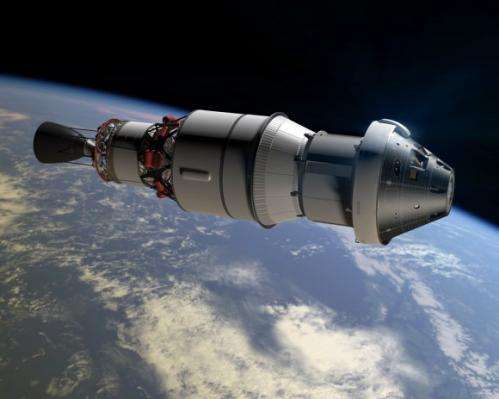Success continues as NASA's Orion parachute tests get more difficult

(Phys.org) —A test version of NASA's Orion spacecraft safely landed during a simulation of two types of parachute failures Wednesday.
In the test, conducted in Yuma, Ariz., the mock capsule was traveling about 250 mph when the parachutes were deployed. That is the highest speed the craft has experienced as part of the test series designed to certify Orion's parachute system for carrying humans.
Engineers rigged one of the test capsule's two drogue parachutes not to deploy and one of its three main parachutes to skip its first stage of inflation after being extracted from a plane 25,000 feet above the Arizona desert. Drogue parachutes are used to slow and reorient Orion while the main parachutes inflate in three stages to gradually slow the capsule further as it descends.
The failure scenario, one of the most difficult simulated so far, will provide data engineers need for human rating the parachute system.
"The tests continue to become more challenging, and the parachute system is proving the design's redundancy and reliability," said Chris Johnson, NASA's project manager for the Orion parachute assembly system. "Testing helps us gain confidence and balance risk to ensure the safety of our crew."
Orion has the largest parachute system ever built for a human-rated spacecraft. The canopies of the three main parachutes can cover almost an entire football field. After reentering Earth's atmosphere, astronauts will use the parachutes to slow the spacecraft for a splashdown in the Pacific Ocean.
Testing irregularities allows engineers to verify the parachutes are reliable even when something goes wrong. The tests provide information to refine models used to build the system and Orion. Changes to the design and materials used in Orion's parachute system already have been made based on previous tests. Other government or commercial spacecraft using a similar parachute system also can benefit from the work done to validate Orion.
"Parachute deployment is inherently chaotic and not easily predictable," said Stu McClung, Orion's landing and recovery system manager. "Gravity never takes any time off—there's no timeout. The end result can be very unforgiving. That's why we test. If we have problems with the system, we want to know about them now."
Orion's next Earth-based parachute test is scheduled for July, when the test capsule will be released from 35,000 feet, a higher altitude than ever before. The first test of the parachutes after traveling in space will be during Exploration Flight Test-1 in 2014, when an uncrewed Orion will be return from 3,600 miles above Earth's surface. The spacecraft will be traveling at about 340 mph when the parachutes deploy.
More information: For more information about Orion, visit: www.nasa.gov/orion
Provided by NASA


















